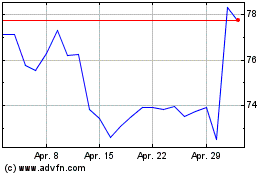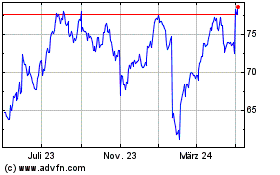(FROM THE WALL STREET JOURNAL 12/9/15)
By David Benoit, Dana Cimilluca, Dana Mattioli and Jacob Bunge
Dow Chemical Co. and DuPont Co. are in advanced talks to merge,
in what would be a combination of two of America's oldest companies
that together are worth nearly $120 billion.
The chemical giants, which each have a market capitalization of
about $60 billion, could announce a merger in coming days, people
familiar with the matter said. It would be followed by a three-way
breakup of the combined company, they said, a common approach to
mergers and acquisitions of late. Dow's Chief Executive Andrew
Liveris is expected to be executive chairman of the new company,
with DuPont CEO Edward Breen keeping that title.
Terms of the deal couldn't be learned, but some of the people
said it would be billed as a merger of equals, meaning there
wouldn't be a big premium for either set of shareholders. A deal
hasn't yet been inked and the talks could fall apart, the people
cautioned.
Even if the two sides manage to agree, there is no guarantee
antitrust regulators would bless the union or that the breakup plan
would address any such concerns. The merger would combine two top
suppliers of industrial and agricultural chemicals and crop
seeds.
Should it come to fruition, a combination of the companies, each
more than a century old, would be one of the biggest in a year
marked by big deals. So far, companies have struck some $4.35
trillion of takeovers in 2015, eclipsing 2007 as the top year on
record for deals, according to Dealogic.
Before any breakup, the deal would create a giant with more than
$90 billion in combined sales and strong positions in everything
from plastics to industrial chemicals and agriculture.
Under pressure from shareholders to slim down and focus on
faster-growing units, both companies have been restructuring their
businesses by shedding some of the products that made them
famous.
The deal under discussion would ultimately accelerate that
process, with the creation of separate businesses housing the
companies' agricultural, materials and material sciences and
specialty-products businesses, some of the people said.
A deal, should one be reached, would come as talks of
consolidation in the agricultural-sciences industry have heated up,
with companies scrambling to adjust to pressure on lower prices for
their commodities.
Last month, The Wall Street Journal reported that DuPont was
discussing a potential combination of its agriculture division with
seed giant Syngenta AG, and separately exploring a potential
agriculture deal with Dow. Monsanto Co. earlier this year abandoned
a $46 billion bid for Syngenta amid resistance from the Swiss
company.
Dow's Mr. Liveris has for more than a decade sought a deal with
DuPont, and reached out to Mr. Breen quickly after Mr. Breen took
the top job at DuPont in October, some of the people said. He
pitched a deal as a way to find synergies before breaking up the
businesses into more focused operations, the people said.
On the agricultural side of their businesses, analysts have long
spoken of the merits of a combination between Dow and DuPont.
Together, the companies sell about 17% of the world's pesticides,
and would be the third-largest supplier of crop chemicals,
according to data compiled by Morgan Stanley. Combined, they would
hold 41% of the U.S. corn seed business and 38% of the soybean
market.
In addition to agricultural products, the companies also have
divisions that make films, coatings, packaging technologies and
other materials used in the food, pharmaceutical, industrial and
automotive sectors. DuPont's stable of goods includes Kevlar fibers
and Corian countertops, while Dow's encompasses Styrofoam
insulations and sunscreen chemicals.
Both companies are U.S. institutions. DuPont was started by a
French gunpowder maker named E.I. du Pont, who came to America in
1800 and broke ground on his first powder mills not long after.
Midland, Mich.-based Dow was founded by electrochemical pioneer
Herbert Henry Dow in 1897.
More recently, the two companies have looked to reshape their
businesses to shed low-margin assets, made from oil and
petrochemicals, in favor of higher-margin specialty products.
DuPont has exited performance paints and coatings, including the
business that invented Teflon nonstick pan coating. Dow, meanwhile,
has gotten out of selling materials like chlorine and the epoxy
used in everything from space travel to Ziploc bags.
The talks come just a month after Wilmington, Del.-based DuPont
named Mr. Breen, a turnaround expert, as the company's chief
executive after a stint as interim CEO. The company's prior CEO,
Ellen Kullman, retired after fending off Nelson Peltz and Trian
Fund Management LP, which sought board seats and criticized the
company -- and its leadership -- for bloated corporate spending and
a continued failure to hit earnings forecasts.
Trian ran a lengthy proxy fight that DuPont defeated, but
DuPont's stock price continued to sag and is currently down nearly
10% for the year. Mr. Breen recently said the company was weighing
deals with rivals.
Last month, Mr. Liveris said his company is exploring deal
possibilities for its agriculture division, which had $7.3 billion
in sales last year.
Dow has also had an activist investor. Last year, the company
added two directors nominated by Daniel Loeb's Third Point LLC
after Mr. Loeb sought a breakup of the company and threatened a
proxy fight. Dow's stock is up 12% this year.
In March, Dow said it would spin off a significant portion of
its chlorine business to chemicals maker Olin Corp. And last year
it said it would separate more of its commodity-based chemicals
business, looking to focus on higher-end specialty concoctions, in
a move to create more stable earnings. Since 2009, Dow has shed
businesses responsible for $15 billion in annual revenues and Mr.
Liveris has suggested the changes are big enough that the company
could even drop "chemical" from its name.
A deal with DuPont would mark a high point for Mr. Liveris's
11-year tenure at the top of the company. While Dow was rocked by
the financial crisis and a deal at that time that nearly sunk the
company, his strategy to realign the company's products has
returned the stock to near all-time highs.
(END) Dow Jones Newswires
December 09, 2015 02:48 ET (07:48 GMT)
Copyright (c) 2015 Dow Jones & Company, Inc.
DuPont de Nemours (NYSE:DD)
Historical Stock Chart
Von Jun 2024 bis Jul 2024

DuPont de Nemours (NYSE:DD)
Historical Stock Chart
Von Jul 2023 bis Jul 2024
